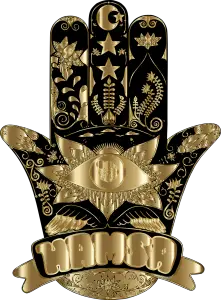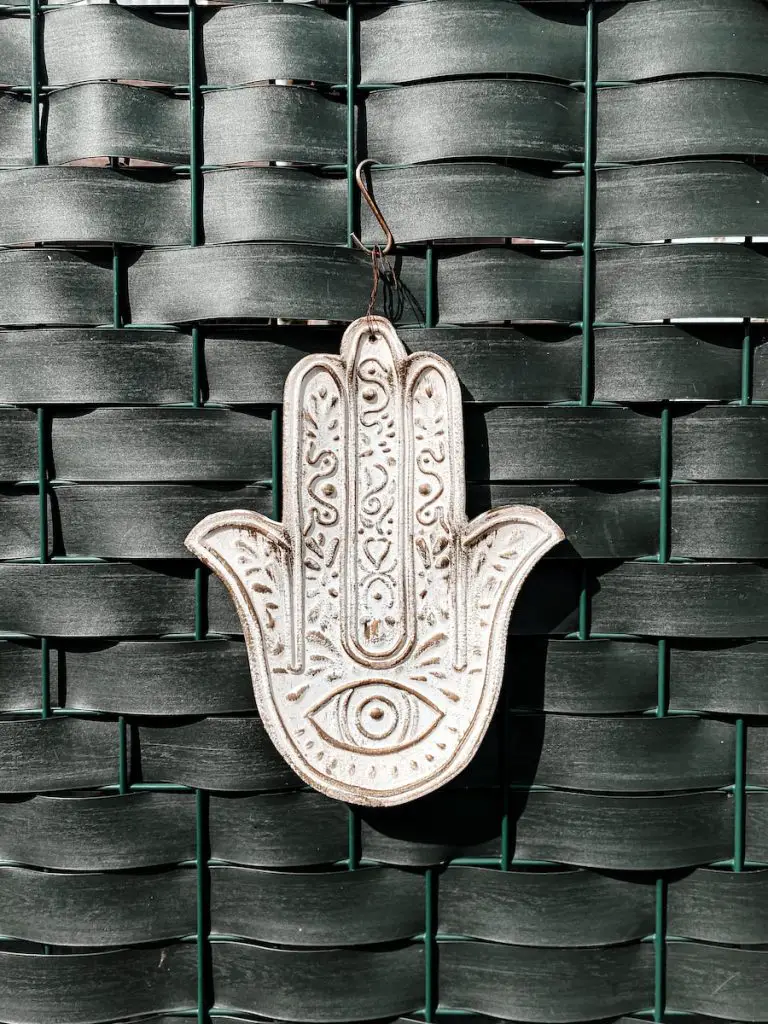The spiritual hand symbol, Hamsa hand, also known as the Hand of Fatima, Hand of Miriam, or Hand of God, is a spiritual symbol that dates back to ancient times. It is a hand-shaped amulet that is believed to bring protection, blessings, and good fortune to those who wear it. The Hamsa hand is a significant symbol in many cultures, including Judaism, Islam, and Christianity, and is often associated with mystical and spiritual beliefs.
The origins of the Hamsa hand are shrouded in mystery, but it is believed to have originated in ancient Egypt or the Middle East. The Hamsa symbol was later adopted by the Jewish and Muslim communities and has since spread throughout the world. The Hamsa hand is often depicted with an eye in the center of the palm, which is believed to offer additional protection against the evil eye.
Despite its ancient origins, the Hamsa hand remains a popular symbol today and can be found in home decor, clothing and Hamsa hand jewelry like Hamsa jewelry, Hamsa bracelets and Hamsa earrings. Many people wear the Hamsa hand as a talisman to ward off negative energy and promote positivity in their lives. Whether you believe in its mystical powers or simply appreciate its beauty, the Hamsa hand is a powerful symbol that continues to captivate and intrigue people around the world.
Spiritual Hand Symbol With Eye
The Hamsa hand with an eye in the center is known as the “Hamsa Hand with Eye” or the “Evil Eye Hamsa Hand”. The eye in the center of the Hamsa hand is known as the “Evil Eye,” and it is believed to offer additional protection against negative energy, evil forces, and the envious or malicious gaze of others.
In many cultures, the Evil Eye is considered a curse that can cause harm or misfortune to those who receive it. The Hamsa hand with the Evil Eye is believed to offer protection against the Evil Eye by reflecting it back to its sender.
The Hamsa Hand with Eye symbolizes the interplay between the forces of good and evil and serves as a powerful talisman for those seeking protection, blessings, solar plexus chakra, root chakra and good fortune. Many people wear jewelry or decorate their homes with the Hamsa Hand with Eye symbol as a way to ward off negative energy and promote positivity in their lives.
Should Hamsa Be Up or Down?
The Hamsa hand is a symbol that can be depicted facing either up or down, and the orientation does not necessarily affect the Hamsa hand meaning or symbolism of the Hamsa.
In some cultures, the orientation of the Hamsa hand symbol is believed to have a specific meaning. Many believe that the five fingers of the Hamsa hand remind its wearer to use their five senses. For example, in Judaism, the Hamsa hand is often depicted facing downwards, with the fingers pointing towards the ground. This orientation is believed to represent the idea of bringing blessings and abundance down from the heavens to earth.
In contrast, in some Islamic faith, the Hamsa hand is often depicted facing upwards, with the fingers pointing towards the sky. This orientation is believed to symbolize the idea of protection and warding off evil from above.
However, it is worth noting that these beliefs about the orientation of the Hamsa hand are not universal, and the symbol is often used in a variety of contexts with different orientations. Ultimately, the orientation of the Hamsa hand is a matter of personal preference and interpretation, and the most important aspect of the symbol is its meaning and significance to the individual using it.
What Religion Is Hamsa?
The Hamsa hand is a symbol that is found in several religions and cultures, including Judaism, Islam, and Christianity. The Hamsa has a long and complex history, and its exact origins are unclear. However, the symbol has been adopted and adapted by various cultures over time, each imbuing it with its own unique meanings and interpretations.
In Judaism, the Hamsa hand is known as the “Hand of Miriam” and is believed to represent the protective and nurturing qualities of the biblical figure of Miriam, the sister of Moses. The Hamsa is often used as a symbol of good luck, protection, and blessings in Jewish culture.
In Islam, the Hamsa hand is known as the “Hand of Fatima” and is associated with the Prophet Muhammad’s daughter, Fatima Zahra. The Hamsa is often used as a symbol of protection, blessings, and strength in Islamic culture.
In Christianity, the Hamsa hand is sometimes used as a symbol of the hand of God and is associated with the Holy Spirit. The Hamsa is often used as a symbol of protection, blessings, and divine guidance in Christian culture. Interestingly, many symbols across various cultures share similar themes of protection and good fortune, such as those explored in articles about lucky birds and good luck plants.
Despite its origins in these three religions, the Hamsa hand has become a widely recognized symbol around the world and is often used in secular contexts as well. The significance and meaning of the Hamsa hand are deeply personal and can vary widely depending on the individual using it. For more insights into the symbolism of various cultural icons, you might find it fascinating to read about koi fish symbolism and Chinese good luck charms.
Exploring how different symbols convey happiness and protection can enrich our understanding of their impact. If you’re interested in further reading on this topic, check out this guide on how to show happiness in writing.
You May Also Like…

